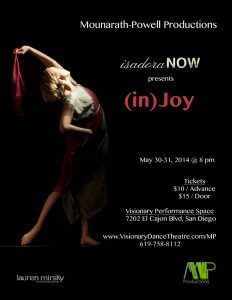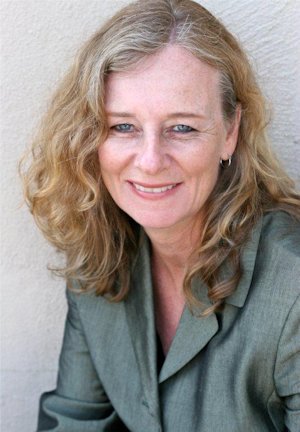Dancing Ghost of Isadora Duncan Seen on El Cajon Blvd.
“Isadora Duncan danced in the homes of wealthy patrons…she wanted dance to be high art,” said Elyssa Dru Rosenberg of IsadoraNOW, a company that preserves the works of the trailblazer famous for dancing bare foot in Greek apparel.
Dressed in flowing fabrics, dancers moved to waltz rhythms and lively mazurkas on silent bare feet in Act I of IsadoraNOW’s (inJoy) at Visionary Performance Space this weekend. The 11 authentic reconstructions of Duncan’s choreography set to familiar works by Chopin, Schubert, and Brahms, and played by pianist Anna Juliar, were beautiful because of their simplicity and grace, and lovely Duncanesque costumes in eye-soothing colors from nature. The collection of dances varied in length and tone. Some were exciting little bursts, and that approach added to the salon experience.
For Isadora aficionados the program was a celebration of artistic freedom, feminism, and a birthday. Born May 27, 1877, in San Francisco, Duncan rejected the constraints of classical ballet and corsets. She preferred loose clothing and bare legs, moved to Europe and took ideas from art and figurines, and natural movement.
“Trio Waltz” introduced key parts of Duncan’s vocabulary, such as arms coiling upward, balances, and hands pressing and fluttering. Our eyes were immediately drawn to the wrists which bent slightly and stretched the palm back, all to send more tension into the forearms.
“Tanagra” set to Schubert, was a fast solo for Stephanie Harvey, a dancer known for athletic modern dance with John Malashock. A short burst of a dance let us appreciate fast spins on gorgeous turned out feet. I can’t imagine that Duncan or her early followers were as strong or well-trained as Harvey.
Another solo with Shauna Tyser, “Gypsy,” showcased Duncan’s love of scarves, which ironically led to her death – her long silk scarf wrapped around the wheel of her car in Nice, France, in 1927. According to Rosenberg, “the red scarf represents virginity, and the dance experiments with flirtation.” Tyser flicked and teased the crowd with her scarf and stomped her feet in a close circle. She drew the scarf close to her body as if to protect it from harm, but teased again with her back to us, pressing her hips left and right while on half toe.
Most of the dances incorporated soft fluttering arms that let the wrists bend slightly. That movement directed our attention to the palms of the hands. Dancers moved along diagonals and circles. Rosenberg explained that Duncan had three children, and her vocabulary grew as a tribute to their spirits. Her two eldest children died in a car crash, the third died in childbirth.
Symbolic movements included the flame with two wrists touching to form a V. That V could also represent the uterus that gives birth to new life. And the soul lives in the solar plexis.
Those symbols were sprinkled throughout the dances. In trios one could visualize Duncan’s three children being taken by an angel. There were several emotional moments like that in the first half. Rosenberg drew gasps when she appeared in ghostly gray, as if conjuring Duncan herself. With her head down, she pressed her hands downward as if burying her sadness. Her hands pressed outward and downward until her fingers quivered and stretched upward as if seeking divine comfort.
“Narcissus” sent soloist Emily Miller down to the floor and rising into Dervish spins. The final “Waltz Brilliante” had four dancers run out of corners then arrange in symmetrical ancient poses like those seen on Grecian vases. Their dance training was obvious when they paired up and whirled in circles.
Act II introduced new works that incorporated Duncan’s values and vocabulary. Dancer Desiree Cuizon was a standout in a commentary about cell phones and selfie photos. Two more works were set to contemporary string scores that rattled the brain for a time, yet threads of Duncan’s influence were there.
The second half would have been better received had it been a separate program. Eyes and ears grew weary. For this full evening, there was nothing more pleasurable and rewarding as the original Isadora.
Visit ©2014 Sue Brenner Photography

Kris Eitland covers dance and theater for Sandiegostory.com and freelances for other publications, including the Union Tribune and Dance Teacher Magazine. She grew up performing many dance styles and continued intensive modern dance and choreography at the Univ. of Minnesota, Duluth, and San Diego State Univ. She also holds a journalism degree from SDSU. Her career includes stints in commercial and public radio news production.
Eitland has won numerous Excellence in Journalism awards for criticism and reporting from the San Diego Press Club. She has served on the Press Club board since 2011 and is a past president. She is a co-founder of Sandiegostory.com. She has a passion for the arts, throwing parties with dancing and singing, and cruising the Pacific in her family’s vintage trawler. She trains dogs, skis, and loves seasonal trips to her home state of Minnesota.
